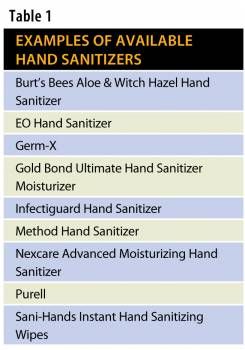Publication
Article
Pharmacy Times
The ABCs of Hand Sanitizers
Author(s):
Hand sanitizing products are everywhere, but are they effective for infection control?
Hand sanitizing products are everywhere, but are they effective for infection control?
Sanitizers Best Serve as Complements to Soap and Water Hand Washing
Studies have demonstrated that proper hand hygiene can decrease the transmission of cold viruses and other germs. The Centers for Disease Control and Prevention (CDC) promote and encourage routine hand washing, especially during cold and influenza season. Because soap and water are not always readily available, hand sanitizers have become a popular alternative in recent years and are routinely used by millions of individuals. These products are clearly convenient, but users should keep in mind that they are only effective for infection control when used properly and in sufficient quantity.
Effective Infection Control
Products currently on the market that are considered effective contain ethyl alcohol (62% to 95% concentration), benzalkonium chloride, salicylic acid, pyroglutamic acid, and triclosan.1 These products are available in fast-drying gels, foams, wipes, and mixed with moisturizing lotions (Table 1). According to the CDC, hand sanitizers containing at least 60% alcohol can quickly decrease the number of germs on hands in many situations, but not all sanitizers are equally effective in eradicating all germs. The CDC also reports that hand sanitizers are not effective when the hands are visibly dirty.2
In an effort to increase awareness about the importance of infection control, some schools have implemented education programs on the topic. Results from a study published in the November 2011 issue of the Pediatric Infectious Disease Journal showed that these types of education programs are successful in getting children to use an alcohol-based hand sanitizer an average of 2 to 4 times a day, and increase awareness about the importance of routine hand hygiene.3,4
A number of other studies have investigated the effectiveness of alcohol-based hand sanitizers. For example, one study looked into the effect of alcohol-based hand sanitizer use by caregivers in an acute care facility on types and rate of infection. Its results showed that the use of hand sanitizers decreased infection rates.5 Researchers conducting another study analyzed the effects of sanitizer use by caregivers on infection types and rates in an extended care facility. They found that infection rates decreased by 30.4% over a 34-month period in units where hand sanitizers were used.6


Results of several other studies, however, have shown that hand sanitizers are not adequately effective against nonenveloped viruses such as the norovirus, which is responsible for the majority of acute gastroenteritis cases.7-9 Another study investigated the effectiveness of hand sanitizers against Clostridium difficile and found that spores were colonizing on the hands of some participants as a result of overreliance on sanitizers.10
Results of a survey of hand washing habits at 161 long-term care facilities revealed at the February 2011 meeting of the American College of Preventive Medicine raised more concerns about the shortcomings of hand sanitizers. The survey’s results showed that 53% of facilities that indicated a preference for using alcohol-based hand sanitizers had confirmed norovirus outbreaks, compared with just 18% of facilities that indicated a preference for soap and water. 8,11,12 These results suggest that the preferential use of hand sanitizers over soap and water for routine hand hygiene might be associated with an increased risk of norovirus outbreaks in long-term care facilities.11
In 2011, the CDC released updated guidelines for the prevention and control of norovirus, including a new recommendation against the use of hand sanitizers as an outright replacement for cleansing with soap and water.9 The CDC’s Updated Norovirus Outbreak Management and Disease Prevention Guidelines state, “The efficacy of alcohol-based and other hand sanitizers against norovirus remains controversial with mixed evidence depending on the product formulation and evaluation methodology… Overall, studies suggest that proper hand washing with soap and running water for at least 20 seconds is the most effective way to reduce norovirus contamination on the hands, whereas hand sanitizers might serve as an effective adjunct in between proper hand washings but should not be considered a substitute for soap and water hand washing.”9
Best Practices
If hand sanitizers are going to be used to complement hand washing, the CDC has a few recommendations to help ensure their proper use. Patients should apply a sufficient amount of product to the palm of 1 hand and rub hands together, making sure to distribute product over all areas of the hands and fingers until they are dry.
In 2011, the FDA also released the following suggestions to consumers regarding the selection and use of hand sanitizers13 :
- Do not purchase OTC hand sanitizers or other products that claim to prevent infection by methicillinresistant Staphylococcus aureus, Escherichia coli, Salmonella, flu, or other bacteria or viruses.
- When in doubt, seek advice from a pharmacist or other health care professional for help in distinguishing between reliable and questionable information on product labels and company websites.
Table 2 presents the CDC’s recommendations on proper hand washing techniques.
When counseling patients about medications, pharmacists should take advantage of the opportunity to remind patients that there is no substitute for proper hand washing with warm water and soap for infection control. Patients should also be reminded to get the annual flu vaccine, maintain a healthy diet, and practice routine hand hygiene to prevent transmission of bacteria and viruses.

Ms. Terrie is a clinical pharmacy writer based in Haymarket, Virginia.
References
1. In: Krinsky D, Berardi R, Ferreri S, et al, eds. Handbook of Nonprescription Drugs. 17th ed. Washington, DC: American Pharmacists Association; 2012.
2. Hand washing: clean hands save lives. Centers for Disease Control and Prevention website. www.cdc.gov/handwashing/. Accessed January 28, 2012.
3. School hygiene program reduced flu cases. Medline Plus website.www.nlm.nih.gov/medlineplus/news/fullstory_118930.html. Accessed January 29, 2012.
4. Reduction in the incidence of influenza A but not influenza B associated with use of hand sanitizer and cough hygiene in schools: a randomized controlled trial. Pediatr Infect Dis J. 2011;30(11):921-926.
5. Hiburn J, Hammond BS, Fendler EJ, Groziak PA. Use of alcohol hand sanitizer as an infection control strategy in an acute care facility. Am J Infect Control. 2003;31(2):109-116.
6. Fendler EJ, Ali Y, Hammond BS, Lyons MK, Kelley MB, Vowell NA. The impact of alcohol hand sanitizer use on infection rates in an extended care facility. Am J Infect Control. 2002;30(4):226-233.
7. Liu P, Yuen Y, Hsiao HM, Jaykus LA, Moe C. Effectiveness of liquid soap and hand sanitizer against Norwalk virus on contaminated hands. Appl Environ Microbiol. 2010;76(2):394-399.
8. Hand sanitizers may actually cause outbreaks of norovirus. Medical New Today website. www.medicalnewstoday.com/articles/232708.php. Accessed January 28, 2012.
9. Hall AJ, Vinjé J, Lopman B, et al. Updated norovirus outbreak management and disease prevention guidelines. Centers for Disease Control and Prevention website. www.cdc.gov/mmwr/preview/mmwrhtml/rr6003a1.htm. Accessed January 29, 2012.
10. Jabbar U, Leischner J, Kasper D, et al. Effectiveness of alcohol-based hand rubs for removal of Clostridium difficile spores from hands. Infect Control Hosp Epidemiol. 2010;31(6):565-570.
11. Blaney DD, Daly ER, Kirkland KB, Tongren JE, Kelso PT, Talbot EA. Use of alcohol based hand sanitizers as a risk factor for norovirus outbreaks in long term facilities in northern New England: December 2006 to March 2007. Am J Infect Control. 2011;39(4):296-301.
12. Zimmerman R. Alcohol-based hand sanitizers associated with norovirus outbreaks. Medscape website. www.medscape.com/viewarticle/737884. Accessed January 29, 2012.
13. Hand sanitizers carry unproven claims to prevent MRSA infections. Food and Drug Administration website. www.fda.gov/ForConsumers/ConsumerUpdates/ucm251816.htm. Accessed January 30, 2012.
14. Hand hygiene basics. Centers for Disease Control and Prevention website. www.cdc.gov/handhygiene/Basics.html. Accessed January 30, 2012.
15. Keeping hands clean. Centers for Disease Control and Prevention website. www.cdc.gov/healthywater/hygiene/hand/handwashing.html. Accessed January 30, 2012. Original 13: Norovirus Technical Fact Sheet. Centers for Disease Control website. www.cdc.gov/ncidod/dvrd/revb/gastro/norovirus-factsheet.htm. Accessed January 29, 2012 (Not used in text)







